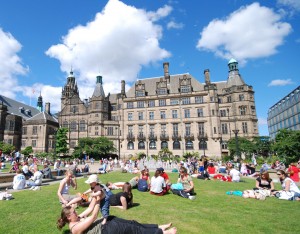It’s theatre by any other name. Usually we call it theatre when we’re sitting in the dark, the people are on stage, with the trappings of formality to tell us where we are. Now, however, it’s a Tuesday afternoon, and I’m sitting in the sun in the Peace Gardens in Sheffield. People watching.
The busy civic space, with the splash of waterworks and fountains, inhibits earwigging, so I just look. Like theatre in a foreign language, you quickly make sense of groupings and dynamics, infer full personalities from slender hints. Everywhere you see micro-scenes, like the snatches of scene in Peter Handke’s The Hour We Knew Nothing Of Each Other, a rare attempt to stage the kaleidoscope of urban life. What would a writer or director see here in Sheffield? What characters would catch their eye?
The student clusters on the grass immediately suggest the tribes of high-school movies, each a coded convocation of signals. I don’t understand the rules – but there surely are rules. Death metal t-shirt and seagreen hair don’t mix with skinny velveteen. Daria specs doesn’t sit among the smartphoners with piercings dabbed at lip and nostril.
Could these teens be a desperate stew of doubt and hormones from Spring Awakening? The friend who maintains that adolescence is a time when emotional flux is mirrored in changing hairstyle would have a field day. Raspberry streaks sprawls beside a pale lad’s island of thick dreads. Peroxide mane chats to effortful topknot. As every theatre designer knows, costume is character.
Other pairings could be outtakes from any number of British playwrights. The elderly couple delving into paninis and Costa coffee – a mam and dad from Alan Bennett, surely? Sarah Daniels might write the middle-aged women in fraught conversation, a vehement talker leaning forward, her listener nodding and clutching her bag to her chest. As for the stern rubbish collector in hi-visibility suiting, startled by the attention when a little kid scampers after him – that’s a Robert Holman vignette in embryo.
Except – guess what? – people don’t pigeonhole so easily. The rubbish collector negotiates the crowd, hoiking his trash clutch above our heads with a fencer’s finesse. Daria specs looks like a geeky outcast, but a handsome couple lope over to share a Coke. Mam and dad drop their grim-weather faces as they tear into a bag of crisps. Mam even puts on outsize shades, and suddenly she’s not Thora Hird, but Susan Sarandon. In just a moment, everything changes.
Which of these people would carry a story? Who has the secrets, or the journey? A muscle guy arrives in his singlet – sunsoutgunsout – and scrolls moodily through his iPod, breathing heavily as if trying to damp down emotion. Yeah, we’ve seen this sentimental education – until a mate arrives and his scowl lifts. He throws off a backflip and grins: Young Werther is a jock. Who knew? A minute later, he walks up the stone steps on his hands, crimson trackie legs aloft. Forget Hamlet, he’s Gene Kelly.
Many people look like characters you recognise from plays – the dudes in impressive quiffs (they look sculpted in fun fur) could be Restoration dandies, the woman with them a sharp dame out of Etherege who’ll see their flirt and raise them. But where are the plays that contain little kid energy? The dinky kids are the anarchists of public space – chasing after pigeons, stripping off and squawking in the fountains, hurtling past the cool kids in ecstasy. Children on stage are all too often polite, precocious, innocent harbingers of plot points. What plays contain this heedless, joy-in-the-moment dynamism?
Art complicates reality, distils and digs and deepens. Or it flattens, making patterns from cheap-shot outlines. Perhaps it depends not on the maker, but on who is watching.
One self-contained dance drama plays out before my eyes. A little boy infiltrates a five-strong circle of young men playing football. They’re twice his height and more than twice his age, so he initially hovers on the edge, then darts to retrieve the ball when it goes astray. He starts to edge closer. They smile at each other’s moves, but it’s no laughing matter for him. He’s rapt, hands on hips to signal seriousness – until he forgets and excitedly clutches the hem of his mauve t-shirt. The choreography mixes virtuosity and manners: the crowded space demands deft little bounces, chest bumps, slowing the ball with hip and heel. The boy seems left behind when the guys get on the phone or chat above his head – but flushed and engaged, his attention never wavers, until he gets a chance to show his own best move: catching the ball in his top. It’s a coming-of-age drama in miniature, a bump on the road to teenagehood.
Eventually, the circle melts. One guy, in a tie and lanyard, must be going back to work. Smiles are exchanged, palms slapped. Except – wait up! – it’s the boy who runs off with the ball. He wasn’t crashing their game, they were joining his. It’s an unexpected perk of people watching. Just another afternoon drama, with a twist.
Image (c) The Balance. Follow David on Twitter: @mrdavidjays


[…] People watching AJBlog: Performance Monkey | Published 2014-07-03 […]